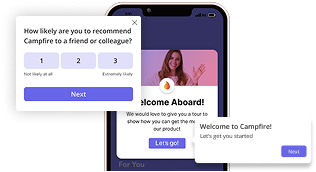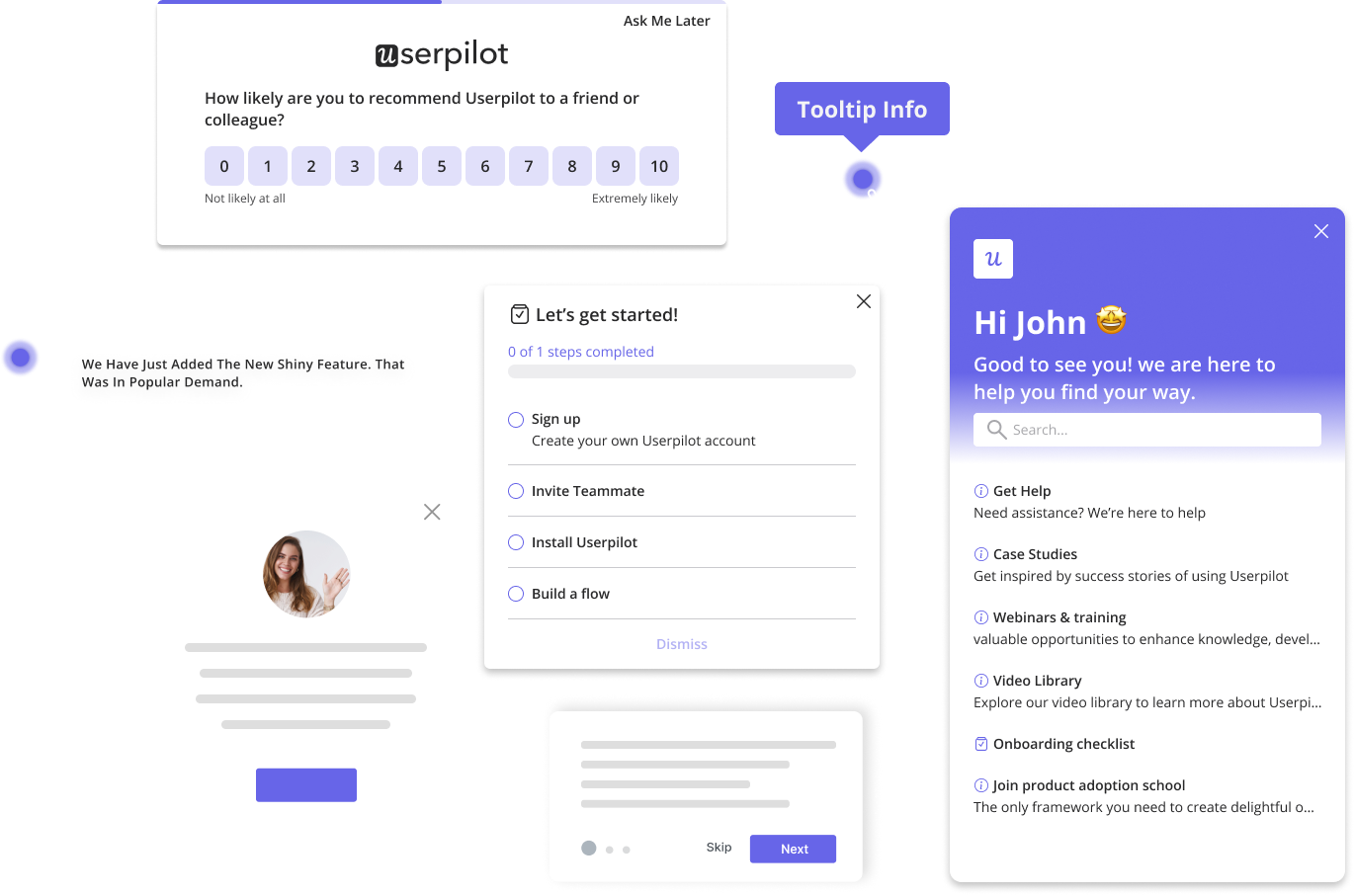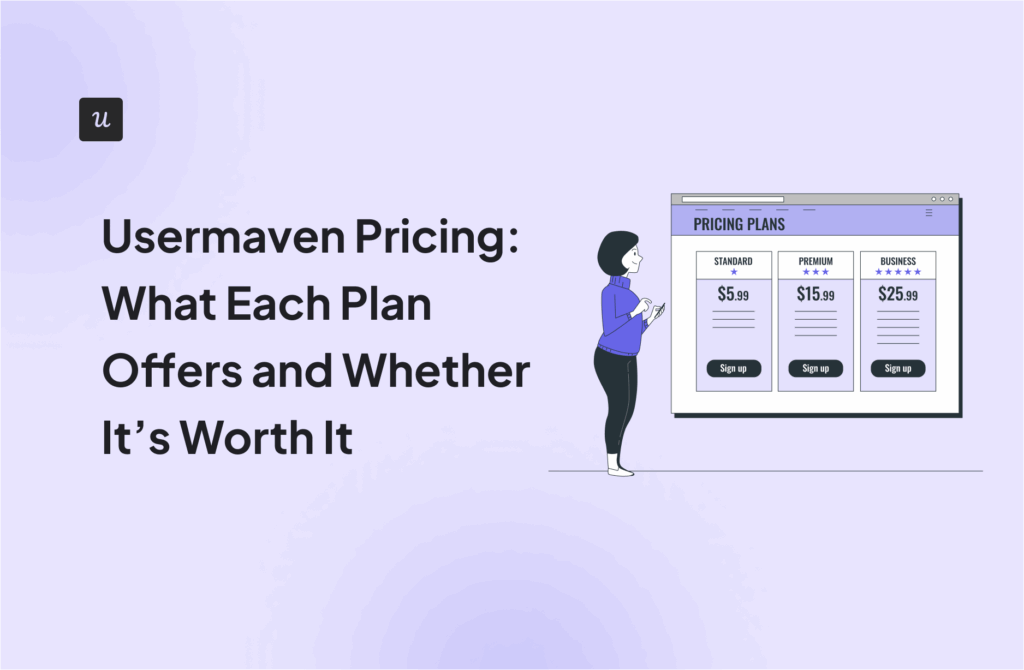
Pendo markets itself as “the first software experience platform.” But in reality, it’s just another all-in-one platform that combines product-related features.
In my experience comparing Pendo with Userpilot, I’ve found that the latter helps me build the same guides, surveys, and reports, but faster. Whereas Pendo has always been overcomplicated, essential processes like tracking server-side events or comparing charts always have extra steps.
However, Userpilot is more than a faster, easier, and more accessible version of Pendo. Interestingly, there are many essential capabilities I take for granted in Userpilot, but you can’t get with Pendo.
Here are 10 of them:
Try Userpilot Now
See Why 1,000+ Teams Choose Userpilot

1. Design an easily accessible onboarding checklist for new users
Userpilot lets me create standalone onboarding checklists that users can access anywhere within the product. Unlike Pendo, these checklists are not limited to the resource center since they can also show up on screen with a widget.

Plus, these checklists can easily be part of a streamlined onboarding process. I can personalize them based on the customer segments, track progress, and trigger in-app walkthroughs when the user clicks on a task.
Pendo, on the other hand, primarily integrates checklists within the resource center. And to be honest, I don’t think it’s a good strategy to put a checklist in a resource center and pray for users to find it, not to mention the friction behind having to open the resource center each time the user completes a task (spoiler: most users will just ignore it).
If you really need to add a checklist in your resource center, you can still choose to do it in Userpilot. With Pendo, you can only get the same thing if you subscribe to Guides Pro, which is only available in the Ultimate plan (i.e., the most expensive one).
So if adding a checklist widget inside your product is a basic priority for you, Userpilot offers the most flexible options without keeping it behind a big paywall.
2. Create out‑of‑the‑box hover‑activated tooltips on any element (no code)
Although both platforms have tooltips, Userpilot lets you trigger them when the user hovers or clicks on a specific UI element. All you need to do is choose between hover and clicks in the tooltip settings. No need to add extra code to make basic in-app guides feel native.

In Pendo’s case, it’s more complicated. The no-code editor can only trigger tooltips when the user hovers over a specific badge or clicks on a UI element. If you want to display a guide when hovering on any element, it must be via custom code.
In short, while Userpilot lets you customize your in-app flows as you like, working with Pendo becomes a cycle of:
- Trying to implement a flow you carefully planned.
- Figuring out Pendo can’t support it, unless you add extra code.
- Delay your product marketing campaign due to this unplanned bottleneck.
3. Launch standalone surveys in real time without burying them in guides
Userpilot offers a standalone feedback feature that allows me to create in-app surveys (such as NPS, CSAT, CES, feature feedback, and more). The survey interface provides:
- A survey builder that allows me to start from a multitude of templates, customize the design, choose any survey question (open text, Likert scale, multiple choice, etc), and set up the logic (e.g., triggering a follow-up question based on the user’s response).)

- A full dashboard to overview all surveys, filter by creator/status/trigger, and export survey data.
- Structured elements like question ordering, throttling, and localization.
- Survey analytics where I can create charts, review metrics (completion rate, completion time, etc), and tag qualitative answers based on common themes.
Pendo, in contrast, supports survey-like feedback (Polls) inside Guides. Each step can host only a single poll, meaning any multi-question survey requires multiple guide steps (which equals more setup and fragmentation). Plus, polls must be added during guide creation and cannot exist as standalone experiences.
Additionally, there’s the Pendo Feedback module, which is disappointing because it’s not designed to collect UX-related feedback via surveys. Instead, it’s just a tool to collect user requests for your product roadmap, which can only be good for passive feedback, but nothing else.
4. Build an integrated in-app resource center and knowledge base
Another Userpilot feature I take for granted is the built-in resource center. Besides integrating our entire knowledge base within our app, it also includes:
- Onboarding flows or video tutorials about specific features so users can revisit them.

- Access to a live chat that provides support without having to leave the product.
- News for feature announcements, updates, or events.
- A search bar where users can type any query and find the resources they need without browsing. There’s also a dedicated tool to analyze the search bar performance and optimize the self-service experience.
Pendo’s resource center also includes announcements and guides. But, adding your knowledge base requires messing with your HTML code and adding iFrames to it (while Userpilot only requires copypasting a URL). Additionally, it lacks a native search bar, which prevents users from easily accessing those resources, thereby increasing friction within your product.
In short, this is another example where Pendo is unnecessarily complicated, which is why Shelterluv changed to Userpilot:
“One of the biggest feedback the team had about Pendo was like, we just don’t know how to use it. And it’s hard to figure out. We don’t have the time to just like, sit and read through everything to figure out how to use it.” – Matthew Brown, Senior Customer Solutions Manager at Shelterluv
5. Turn any untagged interaction into a segment or trigger immediately without dev and pre‑tagging
Userpilot records clicks, inputs, and submissions out of the box. I can use any of those raw interactions with the Visual Labeler and use them right away in user segments, analytics, or as flow triggers without coding.

In Pendo, there’s also an agent that auto‑collects raw events, but it’s more nuanced. First, it only tracks feature clicks and page loads automatically. To use them in product analytics, you must tag features via a CSS selector and create “page rules”.
Any other type of event (e.g., server-side or client-side) must be instrumented by engineers and is not retroactive. This means that if you need to send a campaign to users based on server-side events (e.g., a plan upgrade), then you’d need to configure it with dev help and wait for it to collect enough data.
This is objectively inferior to Userpilot’s autocapture, which lets me track any in-app interaction retroactively without asking devs for help or touching HTML.
6. Capture real-time event data without delays
From the moment I install and enable autocapture, Userpilot starts logging clicks, text inputs, and form submissions. And what’s better, that data appears in our system immediately without any delay.

In contrast, Pendo only processes event data in hourly batches. While segment evaluation may happen in about 5 seconds, most analytics data doesn’t appear until up to 15 minutes after the hour (for example, events captured between 2 PM and 3 PM show up by 3:15 PM).
With Userpilot, I can instantly segment users or trigger flows based on real-time activity. For example, if a user clicks a “Submit Feedback” button, I can fire a tooltip or checklist in real time. In Pendo, by contrast, the same event won’t appear in reports or segments until the next processing cycle, introducing a delay that hinders responsiveness.
7. Track and analyze multi-step user actions in one step
Userpilot offers a visual builder that allows me to group related events into reusable “event groups” (e.g., “Onboarding Steps” or “Feature X Actions”). I can then analyze these groups in trends, funnel reports, and dashboards with a single click.
This grouping means I can track entire workflows or multi-step actions in one report, providing more actionable insights. For example, I could define “all clicks on any menu item” as one group in Userpilot and see that metric instantly.

Pendo, on the other hand, does not offer an analogous GUI for event grouping. You must tag each event separately and analyze them individually. While Pendo allows for grouping by event properties in its Data Explorer, this requires manual setup and does not provide the same level of streamlined analysis as Userpilot’s event groups.
8. Get instant comparative analytics and dashboards
Userpilot’s analytics UI lets me dig into trends with built-in comparison tools. For example, I can overlay data from a previous period to compare changes, or break down funnels by user or company fields on the fly.

Pendo makes this an inconvenience; behavior reports require manually setting date filters or building separate reports to compare periods. For instance, if I want to compare the conversion rates on a funnel in Q2 2025 vs. Q2 2024, I’d have to export CSVs or duplicate the same chart to stitch multi-period comparisons together. With Userpilot, I can make side-by-side comparisons on the same report without back-and-forth.
This difference makes product metrics in Userpilot more transparent and immediately actionable than Pendo, allowing faster data-driven decisions.
9. Enjoy predictable MAU-based pricing and unlimited apps
Userpilot’s pricing is based only on monthly active users (MAUs). With one plan, it can be installed on unlimited domains, apps, and platforms with no per-app fees. Our plans have transparent pricing, and we don’t lock essential features like checklists or NPS surveys behind an add-on.

In contrast, Pendo’s licensing revolves around separate applications and often forces costly upgrades for each new product. Plus, Pendo prices are not public, as the pricing page only shows the plans and the features that are available as add-ons.
So after combining multi-app subscriptions, add-ons, and hidden prices, the final costs skyrocket. It explains why, according to Vendr’s data, the median ACV for Pendo is $48,500/yr.
In short, expanding your product portfolio with Userpilot brings no surprise costs. But with Pendo, adding even one more app or requiring an extra behavior report can trigger a sales negotiation and a higher-tier plan.
10. Access advanced features without paying for extra add-ons or upgrades
The biggest advantage Userpilot has over Pendo is its cost-effectiveness.
For instance, Userpilot’s Starter plan ($299/mo) includes essential product growth tools without requiring higher tiers or extra purchases. Even as the lowest-tier plan, it provides segmentation, standalone in-app checklists, NPS surveys, page analytics, goal tracking, and an entire suite of UI patterns.

If you look at Pendo’s pricing page, it locks essential capabilities like NPS behind its Pulse tier, offers session replays only as an add-on, and reserves product discovery tools for the Ultimate plan. This means that any team looking to run NPS, guide users with checklists, and track adoption trends would need to purchase overpriced plans on top of add-ons.
With Userpilot, instead, you get everything you need on day one, without annoying upsells, and at a fraction of the price.
Choose Userpilot for faster ROI and better experiences!
Based on what I explained, the problem is not that Userpilot offers more tools than Pendo. It’s that Pendo is supposed to be an enterprise-grade product with top-notch delivery, but instead it’s an overpriced platform with half-baked, overcomplicated tools that do the same as Userpilot.
And I don’t say this from my experience only, but from those who have switched from Pendo to Userpilot:

That said, if you’d rather try Userpilot to see how you can streamline your onboarding without coding, book a demo today to start growing your product!
(P.S.: If you want to switch from Pendo, we have a deal where we pay 50% of your contract and give you free access to Userpilot.)
DISCLAIMER: Userpilot strives to provide accurate information to help businesses determine the best solution for their particular needs. Due to the dynamic nature of the industry, the features offered by Userpilot and others often change over time. The statements made in this article are accurate to the best of Userpilot’s knowledge as of its publication/most recent update on August 27, 2025.






